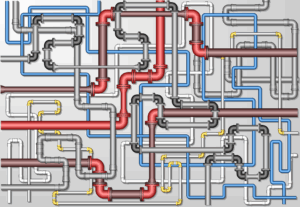Searching for Both Solutions
As i8 Ventures points out in its blog, “Exploitation versus Exploration,” in Charles O’Reilly and Michael Tushman’s Lead and Disrupt: How to Solve the Innovator’s Dilemma, published in 2016, the book maps two types of innovation.
Exploitation innovation emerges from existing assets of the organization and improves them through innovation. This kind of innovation is relatively moderate, focused mainly on enhancement and efficiency — most managers of organizations feel comfortable with it. It deals with questions familiar to them, such as improving existing products. They know the customers and their expectations and thus find it relatively easy to address the challenge of exploiting.
Meanwhile, exploration is the type of innovation that requires the organization to leave its comfort zone and examine new markets, products, and business models unfamiliar to them. From the managers’ perspective, this type of innovation obliges them to venture into unfamiliar territory.
Despite the challenges and opportunities for both perspectives, certainly in an ideal environment, the management, innovation leadership and team could be focused on both. The authors suggest that the team first needs to exploit existing assets and capabilities, and develop incremental improvements, by getting more efficient. This pipeline would then provide for sufficient exploration programs and more radical developments so that the company is still moving forward, and not rendered irrelevant by changes in markets and technologies.
Staying Ambidextrous
All Things Innovation recently looked at the ambidextrous organization, in “Balancing Innovation with Ambidexterity.” Innovators have long been tasked with being a flexible part of an ambidextrous team, as part of an organizational cog that can easily pivot and manage tasks on several levels—both exploitative and explorative. This approach entails focusing on the big picture for the company when needed, yet at the same time being focused on the small, incremental steps that often define and are necessary for entrepreneurship and innovation. Yet, this is a complex and challenging task for both managers and teams in the innovation field. It is a balancing act that looks to require executives to explore new opportunities while exploiting existing capabilities. It is this balance between exploratory (radical) and exploitative (incremental) that is key to the manager’s ability to multitask.
TMRE will be held this year from October 23-25, at the Gaylord Rockies Event & Convention Center, Denver, CO. In the moderated panel, “Examining The Evolution Of Insights Spend & Trends,” All Things Insights’ Seth Adler will explore how dynamic shifts in consumer behaviors have met a flood of new solutions to create a completely unique industry inflection point. Client-side and solution-side industry leaders discuss and debate how organizations have been grappling with change and are now harnessing new tools for transformational outcomes. The panel includes Keith Phillips, Director, Dynata, and Kathryn Topp, CEO and co-founder, Yabble.
Exploiting the Present
Exploitative innovation refers to the development and improvement of existing products, processes, or technologies within an organization. While it might seem that macroeconomic factors primarily influence explorative innovation (creation of entirely new products or services), they can indeed play a significant role in exploitative innovation as well. Here’s how macroeconomic factors can impact exploitative innovation:
- Market Demand and Consumer Behavior: Macroeconomic factors such as economic growth, consumer confidence, and income levels influence market demand and consumer behavior. In times of economic expansion, consumers may have more disposable income, leading to increased demand for improved or upgraded versions of existing products. Exploitative innovation can help businesses capitalize on this demand by delivering enhanced offerings.
- Competitive Landscape: Macroeconomic conditions can affect the competitive landscape. In a competitive market, businesses need to continually innovate to maintain their market share. Exploitative innovation can involve adding new features, improving efficiency, or enhancing customer experience to stay competitive.
- Cost Efficiency and Resource Management: Macroeconomic factors such as inflation, changes in input costs, and supply chain disruptions impact a business’s cost structure. Exploitative innovation that focuses on cost reduction, process optimization, and resource efficiency becomes more relevant during economic downturns when cost pressures are high.
- Regulatory Changes and Compliance: Macroeconomic factors, including changes in regulations and compliance requirements, can necessitate improvements in existing products or processes. Exploitative innovation might involve making adjustments to ensure compliance while maintaining product performance and quality.
- Technological Advances: Macroeconomic trends can drive technological advancements. Businesses often engage in exploitative innovation to adopt emerging technologies and incorporate them into their existing offerings. These advancements can enhance efficiency, reduce costs, or improve product quality.
- Customer Retention and Loyalty: During economic downturns, customers might be more cautious about their spending. Exploitative innovation can focus on retaining customers by enhancing the value proposition of existing products or services, thereby promoting customer loyalty.
- Consumer Preferences and Trends: Macroeconomic factors can influence shifts in consumer preferences and trends. Exploitative innovation allows businesses to adapt to these changes by modifying existing products to align with evolving customer needs and preferences.
- Globalization and Market Expansion: Macroeconomic factors such as international trade agreements and global economic shifts can impact market expansion strategies. Exploitative innovation can involve tailoring existing products for new markets or modifying them to meet local preferences.
- Risk Mitigation and Business Continuity: Macroeconomic uncertainties, such as economic downturns or geopolitical events, can create risks for businesses. Exploitative innovation can focus on diversification, risk mitigation, and building resilience to navigate challenging conditions.
The Explore/Exploit Continuum
In essence, macroeconomic factors influence the overall business environment, which in turn affects the motivations and opportunities for exploitative innovation. Organizations must carefully consider these factors and their implications when planning and executing their innovation strategies, even when the primary focus is on improving existing products or processes.
The explore and exploit continuum rests on different levels of uncertainty, points out Strategyzer in its blog, “Juggling between the future and the present.” For existing exploit business models, you operate with relatively high certainty, and it is possible to make accurate forecasts about sales, and predictions about growth. These business models can be managed and improved through detailed planning and proper execution.
Exploration, meanwhile, is about searching for new value propositions and business models in an environment with high uncertainty. And the further an innovation is from your core business, the higher the uncertainty. A different financial approach, skillset and culture are required to cultivate creation, discovery, validation and acceleration of new ideas. As Strategyzer notes, “However successful today, they don’t rest on their laurels—they are already working on tomorrow.”
Video courtesy of University of Oxford Saïd Business School
Contributor
-

Matthew Kramer is the Digital Editor for All Things Insights & All Things Innovation. He has over 20 years of experience working in publishing and media companies, on a variety of business-to-business publications, websites and trade shows.
View all posts














































































































































































